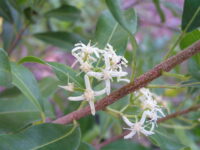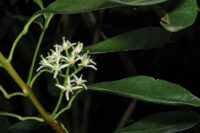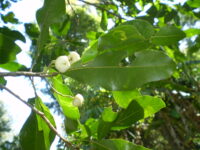Acronychia oblongifolia, commonly known as the “Blunt-leaf Acronychia” or “Hard Aspen,” is a species of evergreen rainforest tree native to eastern Australia.
Belonging to the citrus family, Rutaceae, this tree is valued for its ornamental foliage, fragrant flowers, and its potential medicinal properties.
Taxonomy:
- Family: Rutaceae
- Genus: Acronychia
Description:
- Growth: Medium-sized tree, reaching heights of up to 20 meters.
- Leaves: Glossy and leathery, oblong or elliptical in shape, with a blunt tip, giving rise to its common name. They are arranged alternately along the branches.
- Flowers: Small, white, star-shaped flowers in clusters, which are highly fragrant. Flowering usually occurs in spring and summer.
- Fruit: Small, spherical drupe, turning from green to orange or red when ripe.
Habitat and Distribution:
Acronychia oblongifolia is endemic to eastern Australia, particularly found in rainforests and wet sclerophyll forests of New South Wales and Queensland. It thrives in moist, well-drained soils and prefers shaded areas within its habitat. Regular watering, especially during dry periods, and protection from frost when young, are essential for its optimal growth.
Hosts: (included but not limited to)
- Pied Currawong (Strepera graculina): This omnivorous bird feeds on a wide range of fruits, small animals, and insects. The fruit is a significant food source, especially during times when other fruits are scarce.
- Green Catbird (Ailuroedus crassirostris): Feeding on various fruits, including those of Acronychia oblongifolia. They play a role in seed dispersal and maintaining the health of the forest ecosystem.
- Topknot Pigeon (Lopholaimus antarcticus): This large fruit-eating pigeon relies heavily on rainforest fruits. The fleshy drupes are an important part of its diet. By dispersing seeds through their droppings, they help to ensure the regeneration of the forest.
- Wompoo Fruit-Dove (Ptilinopus magnificus): A frugivorous bird, the Wompoo Fruit-Dove, consumes a variety of rainforest fruits, including those of Acronychia oblongifolia. Its role in seed dispersal is vital for the continuity of the rainforest habitat.
- Grey-headed Flying Fox (Pteropus poliocephalus): Feeds on the fruit and flowers. Their foraging behavior aids in pollination and seed dispersal across wider areas, contributing to the genetic diversity and spread of the species.
Ecology and Uses:
- Ornamental: Due to its attractive foliage and fragrant flowers, Acronychia oblongifolia is cultivated as an ornamental tree in gardens and parks.
- Medicinal: Traditional Indigenous Australian medicine utilizes various parts of the plant for treating ailments such as coughs, colds, and skin conditions. However, scientific research into its medicinal properties is ongoing.
- Fruit Consumption: The edible fruit of Acronychia oblongifolia, though small, is consumed by both wildlife and humans. While not widely cultivated for commercial purposes, the fruit can be harvested and eaten fresh or used in jams, jellies, or desserts.
Links:
Acronychia oblongifolia : White Aspen | Atlas of Living Australia (ala.org.au)
- Arthur Chapman, via Flickr
- Murray Fagg, CC BY 3.0 AU, via Wikimedia Commons
- Zaareo, CC BY-SA 3.0, via Wikimedia Commons




